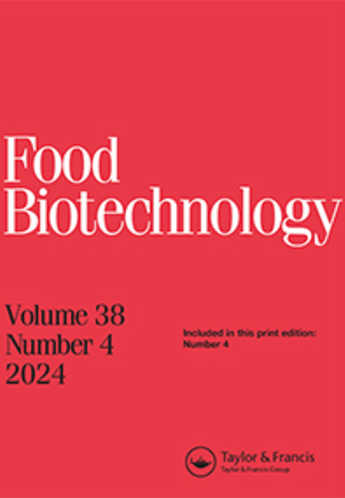Screening of the AhR- and Nrf2-linked transcriptional activities of some cruciferous vegetables and nuts in human intestinal epithelial cells as foods containing endogenous AhR ligand precursors
IF 1.6
4区 农林科学
Q4 BIOTECHNOLOGY & APPLIED MICROBIOLOGY
引用次数: 1
Abstract
ABSTRACT Cruciferous vegetables and nuts are rich in indole-3-carbinol (I3C) and L-tryptophan (L-Trp), respectively, which can be converted upon ingestion into AhR ligands. Activation of AhR by dietary ligands contributes to unlocking its therapeutic potential in gastrointestinal homeostasis. In this study, some cruciferous vegetables (cabbage (red and white), cauliflower) and nuts (sunflower seed kernel, pistachio, cashew, walnut) were investigated for their effects on AhR- and Nrf2-mediated gene expression by using an in vitro digestion/Caco-2 cell culture model. Nuts induced AhR-pathway in a directly proportional manner with their L-Trp contents (sunflower induced the highest (5.3-fold) CYP1A1 expression). Nuts also showed Nrf2-dependent activities, although L-Trp standard did not. Vegetables activated only AhR-pathway, same with I3C standard, and red cabbage induced the highest CYP1A1 expression (9.6-fold). Results suggested the contribution of L-Trp and I3C in AhR-dependent activities of nuts and vegetables, respectively, although there appeared other bioactives to be identified in overall health aspects of these foods.筛选含有内源性AhR配体前体的一些十字花科蔬菜和坚果在人肠上皮细胞中的AhR-和nrf2相关转录活性
十字花科蔬菜和坚果分别富含吲哚-3-甲醇(I3C)和l -色氨酸(L-Trp),摄入后可转化为AhR配体。膳食配体激活AhR有助于释放其在胃肠道稳态中的治疗潜力。本研究采用体外消化/Caco-2细胞培养模型,研究了十字花科蔬菜(红白甘蓝、花椰菜)和坚果(葵花籽仁、开心果、腰果、核桃)对AhR-和nrf2介导的基因表达的影响。坚果诱导ahr通路与其L-Trp含量成正比(向日葵诱导CYP1A1表达最高(5.3倍))。坚果也显示nrf2依赖的活性,尽管L-Trp标准没有。蔬菜仅激活ahr通路,与I3C标准相同,红甘蓝诱导CYP1A1表达最高(9.6倍)。结果表明,l -色氨酸和I3C分别对坚果和蔬菜的ahr依赖性活性有贡献,尽管在这些食物的整体健康方面似乎还有其他生物活性有待确定。
本文章由计算机程序翻译,如有差异,请以英文原文为准。
求助全文
约1分钟内获得全文
求助全文
来源期刊

Food Biotechnology
工程技术-生物工程与应用微生物
CiteScore
3.80
自引率
0.00%
发文量
15
审稿时长
>12 weeks
期刊介绍:
Food Biotechnology is an international, peer-reviewed journal that is focused on current and emerging developments and applications of modern genetics, enzymatic, metabolic and systems-based biochemical processes in food and food-related biological systems. The goal is to help produce and improve foods, food ingredients, and functional foods at the processing stage and beyond agricultural production.
Other areas of strong interest are microbial and fermentation-based metabolic processing to improve foods, food microbiomes for health, metabolic basis for food ingredients with health benefits, molecular and metabolic approaches to functional foods, and biochemical processes for food waste remediation. In addition, articles addressing the topics of modern molecular, metabolic and biochemical approaches to improving food safety and quality are also published.
Researchers in agriculture, food science and nutrition, including food and biotechnology consultants around the world will benefit from the research published in Food Biotechnology. The published research and reviews can be utilized to further educational and research programs and may also be applied to food quality and value added processing challenges, which are continuously evolving and expanding based upon the peer reviewed research conducted and published in the journal.
 求助内容:
求助内容: 应助结果提醒方式:
应助结果提醒方式:


